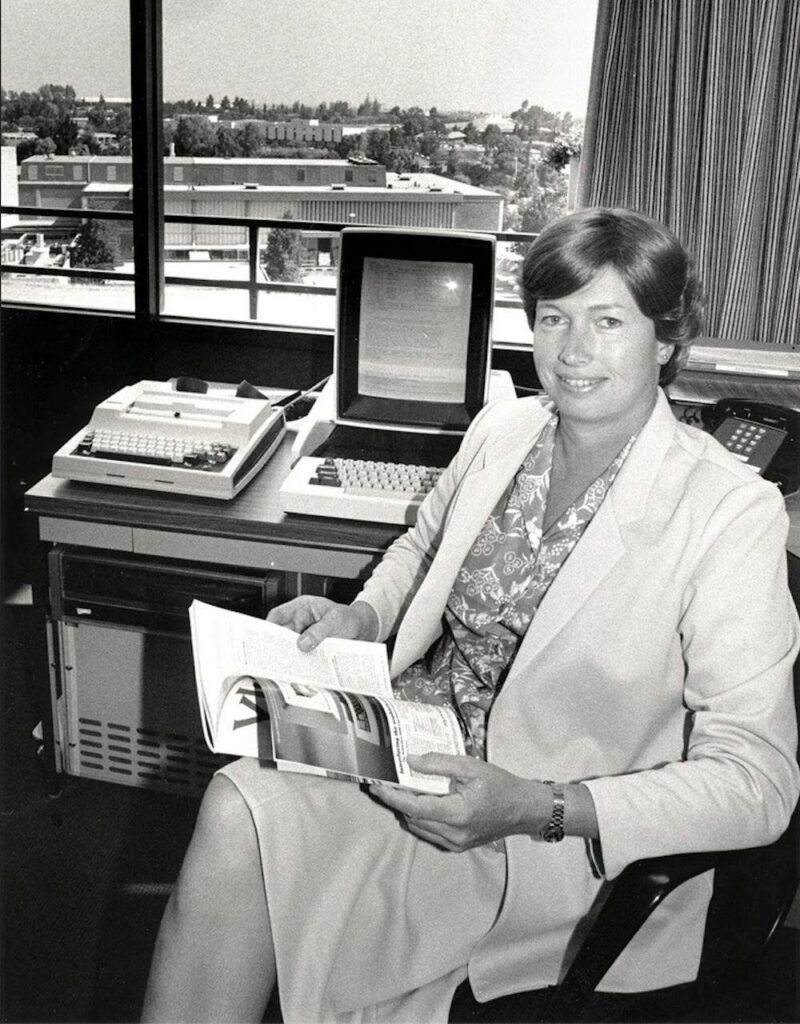Lynn Conway in her office at Xerox PARC in 1983. Photo by Margaret Moulton
Lynne Conway may hold the record for the longest time between being wrongfully fired and receiving an apology. IBM (a company that now covers its logo with a rainbow flag each June for Pride Month) fired her in 1968 after she announced her intention to transition. She died on June 9, 2024, at age 86. IBM eventually apologized to the now-famous computing expert, but not until she was 82, 52 years later.
It didn’t start well for Conway, who began working at IBM as a transgender woman, but she soon found a new job at the prestigious Xerox PARC under her transitioned name and identity, and then hid her transgender identity from her employers for years to avoid being unfairly fired again. In doing so, Conway avoided becoming a target of the sensational and harmful reporting about transgender people that dominated mainstream media in the 20th century. But it also meant that she was unable to fully tell her story.
Even today, mainstream media coverage of transgender issues often portrays transgender people as unfortunate victims or questions their right to exist at all.
Through her groundbreaking work in chip design, Conway joined a long line of notable women in the 20th century computing industry who transformed computers into the powerful and flexible tools they are today. Conway co-invented very large-scale integration (VLSI), which leapt chip design into the future. VLSI allows circuits to be etched onto the surface of computer chips in the most space-efficient way possible, maximizing the number of transistors on the chip.
Maximizing the number of transistors on a chip means that the computers that use it will be as fast and powerful as possible. This innovation earned Conway acclaim from industry and academia – but the recognition was long overdue.
“Conway effect”
However, like many other women in the computer industry, Conway felt that she did not receive the credit she deserved because her male co-inventor of VLSI, Carver Mead, repeatedly received more credit and was mistakenly identified as the leader of the project that led to this important innovation. Although Mead did not necessarily try to unfairly take away credit from her, a phenomenon Conway dubbed “the Conway effect” resulted in Mead getting more, and sometimes all, of the credit.
The Conway effect is a slight modification of a phenomenon known as the Matilda effect, whereby the scientific contributions of women are often credited to the closest man working on the same subject. The Conway effect suggests that people who are “otherized” in the computing field, such as women and people of color of all genders, form a group that society does not expect to make significant advances from, and therefore do not receive the full credit when they do make significant advances because they are literally overlooked.
Credit: National Inventors Hall of Fame
Conway noted that while they initially received some recognition together, Mead was then given an award for their work alone and celebrated alongside the other men at the Computer History Museum in Silicon Valley, while she and other women who did the same work were not invited or similarly recognized, despite being in leadership positions.
Conway wrote about her own experience in an essay introducing “The Conway Effect.”
“In 2009, after a big celebration at the Computer History Museum marking the 50th anniversary of the integrated circuit, I disappeared completely. The media dubbed 16 men the ‘Founding Fathers of Silicon Valley.’ They were inducted into the National Inventors Hall of Fame for their contributions to microelectronics. Most notable were Gordon Moore and Carver Mead. I wasn’t invited to the event, and didn’t even know it was happening.”
Conway was added to the Computer History Museum in 2014, 12 years after Mead. In the computer industry, this innovation is known as the “Mead-Conway System” because Mead’s name is listed first, even though he is not alphabetically first, which gives an indication of this unfortunate influence.
To a new role
Conway has spent much of her career quietly, working and living, making important advances that reshaped the field of computing while avoiding publicity as a transgender woman working in a conservative industry. She later realized that she had tried to keep a low profile if her career was to go down in history, which it eventually did. She also wanted to be credited for her early innovations, before she transitioned.
As a result, she came out as transgender in 1999 and became an active advocate for transgender rights and other transgender people in the tech industry. She ran a website detailing her transgender experience to help other transgender people, especially transgender women who were about to come out, feel less alone. She also participated in a version of The Vagina Monologues starring transgender women in 2004.
Conway went on to have a successful career in computing despite early career setbacks that nearly cost her both her livelihood and her family, and her assessment of her own place and that of other women in the field continues to teach us important lessons about gender and computing, just as the chip architecture she co-designed continues to shape what people can do with the computers that shape our work and personal lives.
Courtesy of The Conversation
This article is republished from The Conversation under a Creative Commons license. Read the original article.
Citation: Lynn Conway is a transgender woman in tech who has been underestimated for decades after helping launch the computing revolution (June 20, 2024) Retrieved June 20, 2024 from https://phys.org/news/2024-06-lynn-conway-trans-woman-tech.html
This document is subject to copyright. It may not be reproduced without written permission, except for fair dealing for the purposes of personal study or research. The content is provided for informational purposes only.

